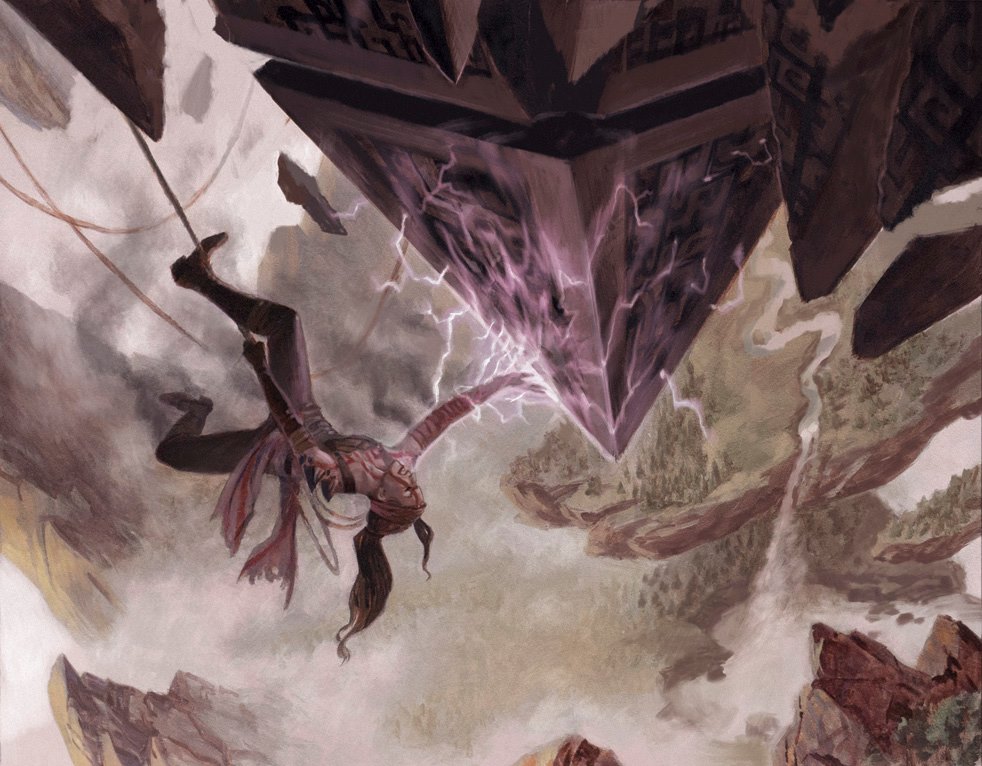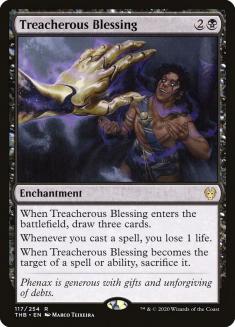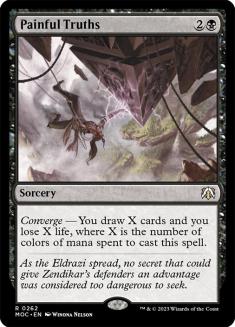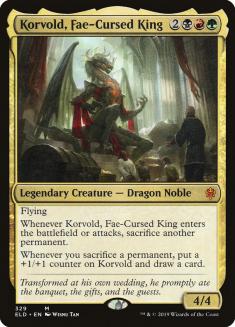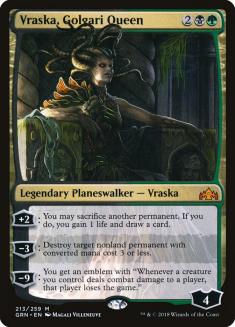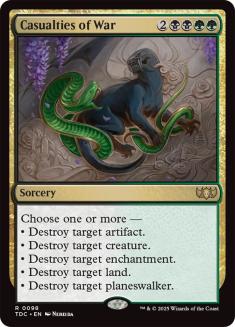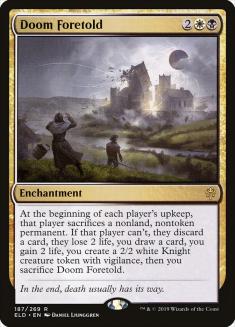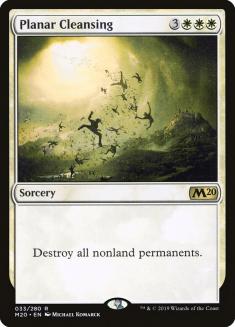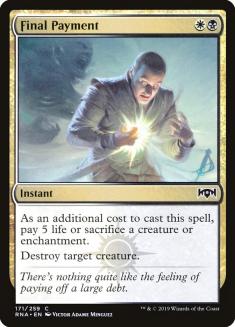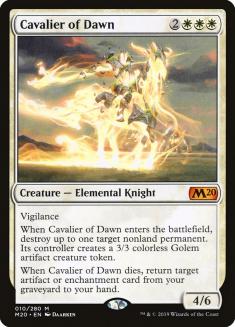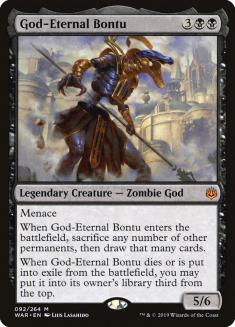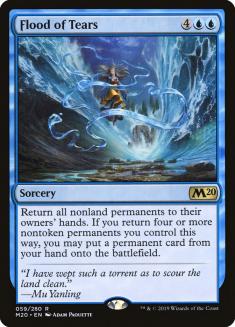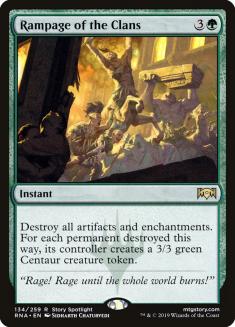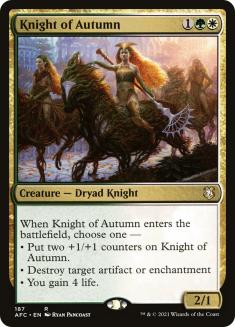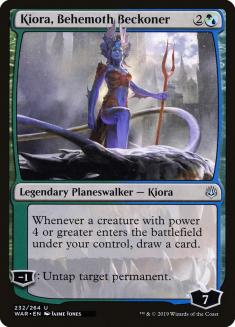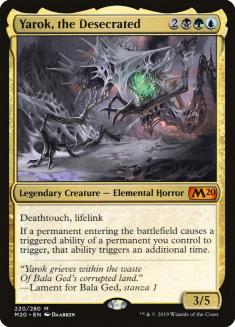Treacherous Blessing is a compelling card to try to make work.
“Greatness at any cost” has become a part of the Magic-player lexicon partially because of the amusing double meaning its wordplay on Dark Confidant contained, but also just because it’s a strategically true statement; card advantage matters a lot in this game, and it is well worth taking some risks or paying some life to gain access to it. As for the rate on Treacherous Blessing, offering three cards for three mana and maybe a few life on top of it, there is a precedent for this very much seeing Constructed play.
The dream with Painful Truths was that for three mana and three life, you’d get to peel three fresh new cards off the top of your deck. This card sees a lot less eternal play than it used to, but was a staple of Standard when it was legal, especially in the Jeskai Black control deck from a few years back. Painful Truths played well in decks that were at least three colours, and so usually slower midrange and control decks, and was perfect both for refueling your hand with a bunch of cheap interaction that would make up for the tempo loss of taking time off drawing cards and for helping you hit land drops to enable efficient multi-spelling.
Treacherous Blessing on its surface offers something similar; for a bit of time and mana, and a few life on top, you’ll refresh your hand for the game ahead. However this card is a very different animal from Painful Truths, as the longer this enchantment stays on the battlefield the more it is going to nibble away at your life total, bleeding you closer and closer to death. Losing one life per turn is going to really add up if you cast this on Turn 4 or 5 in your slow midrange deck and just never bother to try to get it off the battlefield.
This is about when I’m normally meant to explain how this exciting new card works perfectly with Teferi, Time Raveler, just like how seemingly every preview card often does. Treacherous Blessing comes with an important last clause, though, stating that if it is ever targeted then you sacrifice it. This is sad for Teferi, as his attempts to bounce it will result in the Blessing being sacrificed and your Teferi won’t even draw you a card, but this also makes for a fun little game of trying to figure out how you do get this enchantment off the battlefield profitably.
So, let’s set some ground rules. Whatever ways you’re using to get this off the table, it is unacceptable for that card to exclusively remove the Blessing and do nothing else; if you spend a Disenchant to remove your Treacherous Blessing, it is like the Blessing only drew you two cards instead of three. We also don’t want to be going too far out of our way to take the Blessing off the battlefield; ideally removing it just incidentally happens as you play Magic and as you use your cards as they’re intended.
Creatures (21)
- 2 Thrashing Brontodon
- 4 Mayhem Devil
- 1 Massacre Girl
- 4 Gilded Goose
- 3 Korvold, Fae-Cursed King
- 2 Murderous Rider
- 4 Cauldron Familiar
- 1 Klothys, God of Destiny
Planeswalkers (1)
Lands (25)
Spells (13)

Let’s just start this by getting the obvious out of the way: Treacherous Blessing loves being sacrificed, and it turns out one of the very best decks in Throne of Eldraine Standard does an awful lot of sacrificing. Between Korvold, Fae-Cursed King and Vraska, Golgari Queen, we have a few cards in our deck that can sacrifice Blessing and give us an extra card for our troubles, and Casualties of War can incidentally tag our Blessing whilst sweeping away a few of our opponent’s permanents at the same time. If you don’t remove the Blessing for a few turns, it likely doesn’t matter as much in this deck too thanks to the lifegain that Cauldron Familiar, Food tokens, and Klothys, God of Destiny provide.
This is a perfect example of how Treacherous Blessing is at its best when you just incidentally remove it whilst you play normal Magic. Jund Sacrifice already wants throw-away permanents it can turn into new cards via Korvold or Vraska, so getting the card off the battlefield will often just come naturally. Jund Sacrifice is a deck that periodically played Midnight Reaper, and whilst Reaper has a higher ceiling than Blessing when everything is going to plan, it also has a lower floor when you’re resource-light and don’t have much of a battlefield, so it’s very conceivable that the deck will experiment with playing some copies of Blessing somewhere in the 75.
Creatures (3)
Planeswalkers (5)
Lands (25)
Spells (27)

The other home for Blessing among established decks is Esper Dance. Doom Foretold happily sacrifices your Blessing whilst your Blessing simultaneously fuels your Doom Foretold, and Planar Cleansing is a powerful sweeper than incidentally gets the Blessing off the table. Again, you’re not having to work very hard here to remove Blessing, instead just incidentally removing it as a part of playing Magic.
Wishclaw Talisman helps tie all this together as it can always go grab you a Doom Foretold or Planar Cleansing if you’re in need of one. Esper Dance being a fairly slow control deck makes the pain inflicted from Blessing somewhat intimidating, but you can always sideboard it out in the matchups where that pain is a problem, and the lifegain from Oath of Kaya helps relieve that pain at least a bit.
Creatures (10)
Planeswalkers (1)
Lands (25)
Spells (24)

A different take on trying to sacrifice Treacherous Blessing to Doom Foretold, Sagas work nicely with Doom Foretold as your Turn 3 Tymaret Calls the Dead will be sacrificed to your Turn 4 Doom Foretold on your fifth turn, after it has already produced a pair of Zombie tokens for you. Whilst you can’t sacrifice an on-curve The Birth of Meletis to a Doom trigger, you can still sacrifice one that you draw a bit later in the game whilst still having found a Plains and made an 0/4.
Cavalier of Dawn is a card that I think is very powerful and has mainly not seen play due to white not really having a home in Standard so far; depending on how many good new white cards we get from Theros Beyond Death, this Cavalier could be ready to make an appearance. Here it is particularly nice as a versatile piece of interaction that also happily blows up your Blessing if you need it too. You don’t get a 3/3 from the enters-the-battlefield trigger if you do this, but you do get to return the Blessing from your graveyard to your hand when the Cavalier dies. The Cavalier fits in well in this deck even outside of being able to remove and recur Blessing, as it will happily turn a Golden Egg, Oath of Kaya, or The Birth of Meletis into a 3/3 once they’ve done their job.
Of course, there’s nothing saying that you have to remove the Blessing from the table…
Creatures (24)
- 4 Gutterbones
- 4 Footlight Fiend
- 4 Rotting Regisaur
- 4 Knight of the Ebon Legion
- 4 Order of Midnight
- 4 Cauldron Familiar
Lands (22)
Spells (14)
Sideboard

So far we’ve thought of Blessing’s life loss as a downside that we have to cut short by removing the enchantment that is afflicting us. Whilst it’s true that this life loss is a downside, the extent to which this downside is detrimental to you depends on how much damage you really expect your opponent to deal to you and how much longer you really expect the game to go.
This deck is really hoping another good one-mana black creature is previewed for Theros Beyond Death, but seeks to see what happens if you cast your Blessing with no intention of ever removing it from the battlefield. After all, you won’t take much damage from your Blessing if your opponent just dies in a couple of turns’ time. Draw three cards, cast all the one-mana cards you find, and just hope the wealth of resources is too much for your opponent.
More realistically, if we’re going to see a deck take this approach, it’s not hard to imagine a deck like Rakdos Knights adding a copy or two of Blessing to its sideboard. Against control decks your life total rarely matters, so you’ll happily sideboard them in, accept taking a few damage, and hope the card advantage closes out the game quickly. Meanwhile, you just leave the Blessings sitting in your sideboard against decks that can actually pressure you.
If you’re looking for other inspiration as far as cards that help enable Treacherous Blessing, or work particularly well with it, here are some cards that I couldn’t quite manage to make work with only half of the Theros Beyond Death previews available to me:
The coolest thing here is the notion of a Yarok, the Desecrated enchantment-based deck. You can play Setessan Champion which will trigger twice in response to any enchantments entering the battlefield under your control when you have a Yarok, and then enchantments like Banishing Light or Treacherous Blessing will double up as a result of Yarok’s ability also. The main problem at present is that there haven’t been enough appealing enchantments previewed for a strategy like this, but there are still plenty of previews yet to come.
Treacherous Blessing certainly offers you a lot of card advantage, but at a price. How real that price is to you depends on how proactive you’re going to be in ending the game, and like we’ve explored, there are plenty of ways to lower the cost too if you’re interested in the game continuing for a long time.
Happy card drawing!

